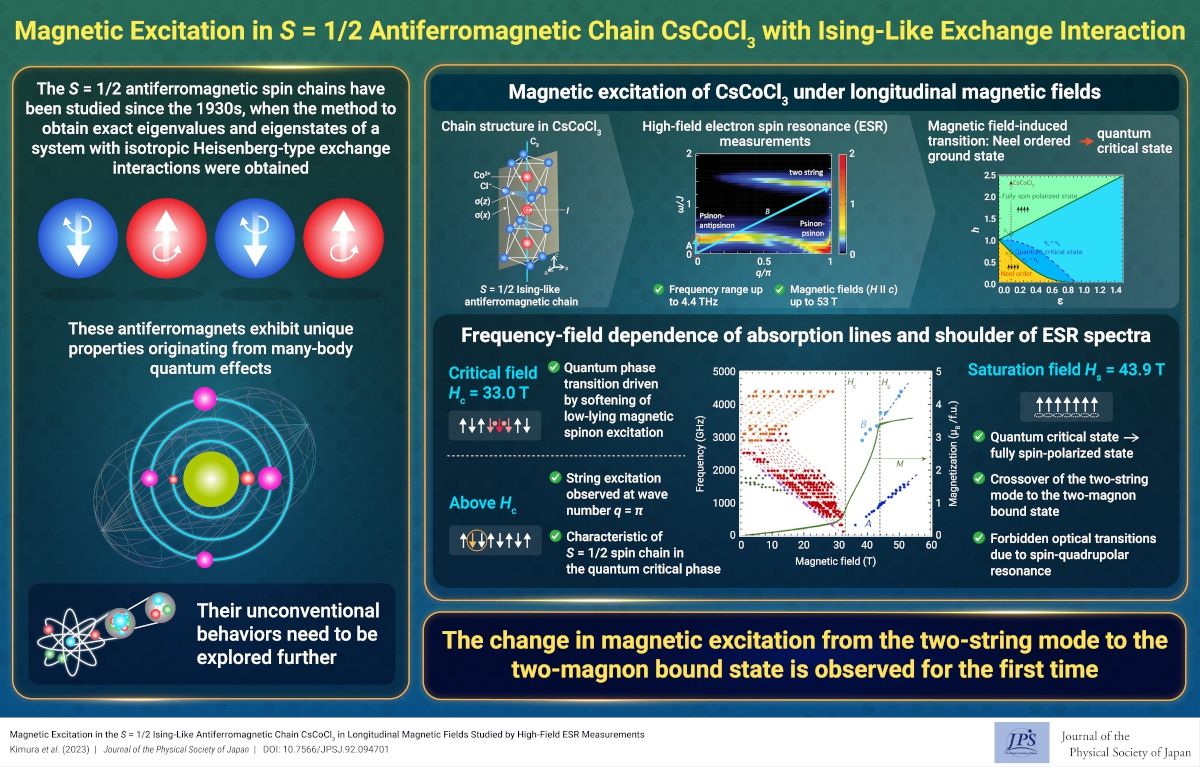Magnetic Excitation in S = 1/2 Antiferromagnetic Chain CsCoCl3 with Ising-Like Exchange Interaction
© The Physical Society of Japan
This article is on
Magnetic Excitation in the S = 1/2 Ising-like Antiferromagnetic Chain CsCoCl3 in Longitudinal Magnetic Fields Studied by High-field ESR Measurementss
(JPSJ Editors' Choice)
J. Phys. Soc. Jpn.
92,
094701
(2023)
.
The results of high-field electron spin resonance measurements in the millimeter-wave to terahertz region reveal unconventional magnetic excitation in S = 1/2 one-dimensional antiferromagnets.

The one-dimensional antiferromagnet with spin S = 1/2 has been studied since 1931 when H. Bethe proposed a method to obtain the exact eigenvalues and eigenstates of a system with isotropic Heisenberg-type exchange interactions. Research has revealed that the simple S = 1/2 one-dimensional antiferromagnet exhibits rich and exotic properties originating from the many-body quantum effects. In the case of the most-investigated system with isotropic Heisenberg-type interactions, the quantum fluctuations destroy the long-range order, leading to a quantum critical state with algebraic decay of the spin correlation function. The magnetic excitation from this fluctuating ground state exhibits a marked contrast from that of the classical spin wave. The lowest-energy excitation in the S = 1/2 one-dimensional antiferromagnet is a pair excitation of quasi-particles called spinons, which are mobile domain walls created by flipping the spins from its ground state. Under external magnetic fields, the magnetic excitation becomes gapless at incommensurate wave numbers in the reciprocal lattice space. In addition, recent theory has indicated that the string states, which are characterized by complex rapidities in the Bethe-anzats calculations, change asymptotically to multimagnon bound states upon increasing the field, significantly contributing to the excitation spectrum.
We investigated the magnetic excitation in the S = 1/2 one-dimensional antiferromagnet with Ising-like anisotropy CsCoCl3 through high-field electron spin resonance (ESR) spectroscopy in a wide frequency region from 130 GHz to 4.4 THz under pulsed magnetic fields up to 53 T. In contrast to the Heisenberg-type system, the antiferromagnetic order is maintained in the ground state of the S = 1/2 Ising-like one-dimensional antiferromagnet at zero magnetic field, owing to magnetic anisotropy. However, by applying the magnetic field along the magnetic easy axis, the system transitions into the quantum critical state. Our ESR results demonstrate that the softening of the spinon by the external magnetic field drives this field-induced transition. This result suggests that the antiferromagnetic order is destroyed by the propagating domain walls induced in the ground state by the longitudinal magnetic field. Thereby, the spin chain is brought into the quantum-critical state with no long-range order. In the quantum critical state, we observe the appearance of a two-string state in the terahertz region above 2.9 THz. By increasing the magnetic fields further, to the saturation field, we can successfully observe the change in the magnetic excitation from the two-string to the two-magnon bound state, for the first time.
(Written by Shojiro Kimura on behalf of all the authors)
Magnetic Excitation in the S = 1/2 Ising-like Antiferromagnetic Chain CsCoCl3 in Longitudinal Magnetic Fields Studied by High-field ESR Measurementss
(JPSJ Editors' Choice)
J. Phys. Soc. Jpn.
92,
094701
(2023)
.
Share this topic
Fields
Related Articles
-
Higher-Order Topological Phases in Magnetic Materials with Breathing Pyrochlore Structures
Electronic structure and electrical properties of surfaces and nanostructures
Magnetic properties in condensed matter
Mathematical methods, classical and quantum physics, relativity, gravitation, numerical simulation, computational modeling
2025-4-7
A simple example of a higher-order topological phase, in which the symmetry decreases step-by-step from the bulk to the corner, is realized in a magnetic system with a pyrochlore structure and is characterized by a series of quantized Berry phases defined for the bulk, surface, and edge.
-
Existence of Chiral Soliton Lattices (CSLs) in Chiral Helimagnet Yb(Ni1-xCux)3Al9
Magnetic properties in condensed matter
2025-4-1
Our study examines the magnetic structure of the monoaxial chiral helimagnet Yb(Ni1-xCux)3Al9, providing first direct evidence of the formation of chiral soliton lattice state.
-
Understanding Pressure-Induced Superconductivity in CrAs and MnP
Magnetic properties in condensed matter
2025-3-10
This study reviews existing research on the pressure-induced variation of magnetic properties of transition metal mono-pnictides like CrAS, MnP, and others, aiming to understand the unconventional superconductivity observed in CrAs and MnP.
-
Symmetry and AI: Building the Future of Physics Simulations
Magnetic properties in condensed matter
Measurement, instrumentation, and techniques
2025-2-18
Generative artificial intelligence (AI) has gained considerable attention in scientific fields. By embedding physical symmetry into AI before training, we created a faster and lighter model. Scaling improves the accuracy and unlocks the potential of physics research and applications.
-
Triangular Lattice Magnet GdGa2: Spin Cycloids and Skyrmions
Cross-disciplinary physics and related areas of science and technology
Electronic transport in condensed matter
Magnetic properties in condensed matter
2025-2-3
Careful measurements were conducted on the hexagonal magnet GdGa2 to reveal the experimental signatures of ultrasmall spin cycloids and of a potential Néel-type skyrmion lattice phase induced by a magnetic field.




